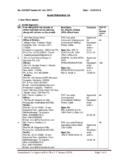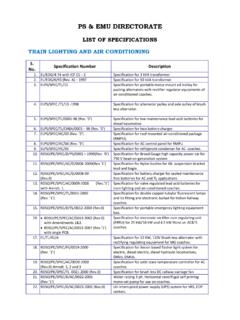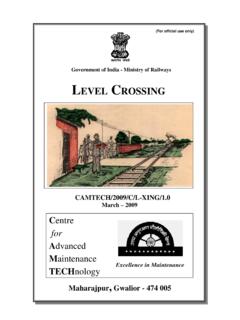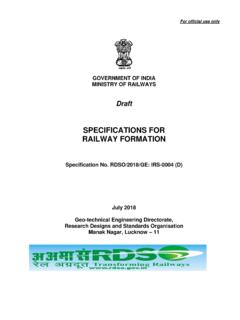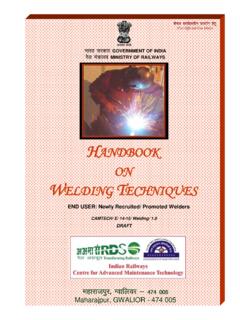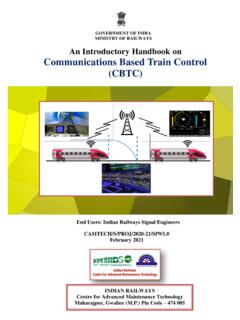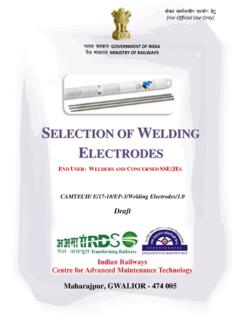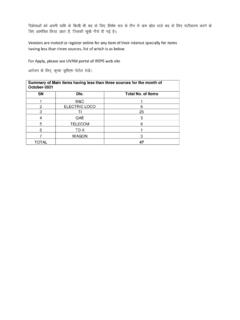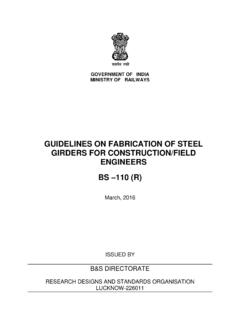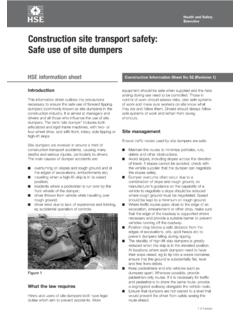Transcription of STUDY REPORT ON COMPACTION EQUIPMENTS AND …
1 GOVERNMENT OF INDIA MINISTRY OF RAILWAYS STUDY REPORT ON COMPACTION EQUIPMENTS AND construction machinery REPORT No. GE- R-76 SEPTEMBER - 2005 Geotechnical Engineering Directorate Research Designs & Standards Organization Manak Nagar, Lucknow-11 CONTENTS DESCRIPTION PAGE NO. 1. INTRODUCTION 1 2. SCOPE 1 3. IMPORTANCE OF ADEQUATE COMPACTION OF EARTHWORK 1 4. FACTORS AFFECTING COMPACTION IN THE FIELD 1 5. FIELD COMPACTION TRIALS 3 6. TYPE OF COMPACTING EQUIPMENTS 3 7. construction machinery 21 8. CONCLUSION 29 9. REFERENCES 29 1 INTRODUCTION: In earlier days, embankment design and construction were not given adequate attention.
2 Embankments were constructed and left for COMPACTION by natural process. Due to loads imposed by heavier axle loads, very high degree of sub-grade support have become necessary in present scenario which requires fast and heavy COMPACTION by suitable compacting EQUIPMENTS . The densification of soil mass, commonly known as COMPACTION , results in an alround improvement of soil properties and its performance as a pavement supporting bed. Many types of compacting EQUIPMENTS are available now a days for compacting different types of soils to be used in earthwork. The construction machineries, like backhoe, dozers, graders, scrapers, JCBs and dumpers etc. began to be deployed on road / rail formation and earth dam construction works in order to complete the works in comparatively less time and expenditure. SCOPE: Scope of this REPORT is to present various types of COMPACTION EQUIPMENTS and construction machinery deployed to construct the railway embankment generally required.
3 IMPORTANCE OF ADEQUATE COMPACTION OF EARTHWORK: COMPACTION is the process of increasing the density of soil by mechanical means by packing soil particles closer together with reduction of air voids and to obtain a homogeneous soil mass having improved soil properties. COMPACTION brings many desirable changes in soil properties as follow: (a) Helps soil to acquire increase in shear strength (b) Reduces compressibility thus minimizing uneven settlement during service (c) Increase density and reduces permeability, thereby reducing susceptibility to change in moisture content (d) Reduction in erodability (e) Results in homogeneous uniform soil mass of known properties (f) Reduction in frost susceptibility in cold regions (g) Helps the pavement designer in assessing the sub-grade strength to a reasonably accurate strength and thereby produce a safe and economical design (h) Results in little change in volume under traffic loads, thus minimizing deformation and maintaining good rideability characteristics of the pavement (i) Reduces expenditure on maintenance of formation during service FACTORS AFFECTING COMPACTION IN THE FIELD.
4 COMPACTION of a particular soil is affected by following given factors (i) COMPACTIVE EFFORT In modern construction projects, heavy COMPACTION machinery is deployed to provide COMPACTION energy. Types of machinery required are decided based on type of soil to be 2compacted. The method of COMPACTION is primarily of four types such as kneading, static, dynamic or impact and vibratory COMPACTION . Different type of action is effective in different type of soils such as for cohesive soils; sheepsfoot rollers or pneumatic rollers provide the kneading action. Silty soils can be effectively compacted by sheepsfoot roller/pneumatic roller or smooth wheel roller. For compacting sandy and gravelly soil, vibratory rollers are most effective. If granular soils have some fines, both smooth wheel and pneumatic rollers can be used. (ii) MOISTURE CONTENT Proper control of moisture content in soil is necessary for achieving desired density.
5 Maximum density with minimum compacting effort can be achieved by COMPACTION of soil near its OMC (Optimum Moisture Content). If natural moisture content of the soil is less than OMC, calculated amount of water should be added to soil with sprinkler attached to water tanker and mixed with soil by motor grader for uniform moisture content. When soil is too wet, it is required to be dried by aeration to reach up to OMC. (iii) SOIL TYPE Type of soil has a great influence on its COMPACTION characteristics. Normally, heavy clays, clays and silt offer higher resistance to COMPACTION where as sandy soils and coarse grained or gravelly soils are amenable for easy COMPACTION . The coarse-grained soils yield higher densities in comparison to clays. A well-graded soil can be compacted to higher density. (iv) LAYER THICKNESS The more the thickness of layer of earth subjected to field COMPACTION , the less the energy input per unit weight of soil and hence, less is the COMPACTION under each pass of the roller.
6 Suitable thickness of soil of each layer is necessary to achieve uniform thickness. Layer thickness depends upon type of soil involved and type of roller, its weight and contact pressure of its drums. Normally, 200-300 mm layer thickness is optimum in the field for achieving homogeneous COMPACTION . (v) CONTACT PRESSURE Contact pressure depends on the weight of the roller wheel and the contact area. In case of pneumatic roller, the tyre inflation pressure also determines the contact pressure in addition to wheel load. A higher contact pressure increases the dry density and lowers the optimum moisture content. (vi) NUMBER OF ROLLER PASSES Density of the soil increases with the number of passes of rollers but after optimum number of passes, further increase in density is insignificant for additional number of cases.
7 For determination of optimum number of passes for given type of roller and optimum thickness of layer at a predetermined moisture content, a field trial for COMPACTION is necessary as indicated in para of Guidelines for Earthwork in Railway Projects, July 2003 and para of this REPORT . (vii) SPEED OF ROLLING Speed of rolling has a very important bearing on the roller output. The greater the speed of rolling, the more the length of embankment that can be compacted in one day. Speed was found to be a significant factor for vibratory rollers because its number of vibrations per minute is not related to its forward speed. Therefore, the slower the speed of travel, the more vibrations at a given point and lesser number of pass required to attain a given density. FIELD COMPACTION TRIALS: With the help of field COMPACTION trials, the appropriate type of roller for particular type of soil, optimum depth of layer of soil to be compacted and optimum moisture content of the soil to be used for COMPACTION can be determined.
8 For this, a ramp of following dimension is prepared. Each strip is rolled with using different moisture contents, type of roller and different thickness of lift of soil. Finally, by plotting the graph (fig-1a) between various parameters used, the desired parameters are determined. Figure 1: Sketch showing ramp for field COMPACTION trial Figure-1(a) : Curves for determination of appropriate depth of layer TYPE OF COMPACTING EQUIPMENTS A large variety of mechanical EQUIPMENTS is available for COMPACTION of soil but soil type and moisture condition will often dictate the type of EQUIPMENTS and method of use. Some important compacting equipment are given below: - 1. Light compacting EQUIPMENTS (Rammers/Plate compactors) 2. Smooth wheel rollers 3. Sheepsfoot rollers 4. Pneumatic tyred rollers 5. Vibratory rollers 6. Grid rollers The details about various types of rollers are given as below: - LIGHT COMPACTING EQUIPMENTS : RAMMERS: Rammers are the light compacting EQUIPMENTS used for small areas, which provide impact load.
9 These may be hand or machine operated. The area of base is normally 15cm x 15cm or 20cm x 20cm or more. Free fall rammers can be heavier type also weighing 2 or 3 tonne lifted and dropped by cables to a height of 1 or 2m to compact large rock fragments. Automatic type operated pneumatically or using petrol engines lift to a height of 15 to 20 cm. before being dropped. Weight of such tampers can vary from 30 to 10000kg. They are suitable for compacting cohesive soils as well as other soils. Figure 2 : Plate Rammer 4 VIBRATING PLATE COMPACTORS: These vary in weight from 100 kg to 2 tonne with plate areas between sqm and sq cm. Smaller versions are manually guided and therefore suitable for compacting small or awkwardly shaped areas. They usually travel at about km/h. They are classified in terms of mass divided by the area of the base in contact with the ground. Vibrating plate compactor Figure 3: Vibrating Plate Compactor VIBRO TAMPERS: Vibro tampers COMPACTION is induced by vibrations set up in a base plate through a spring activated by an engine driven reciprocating mechanism.
10 They are usually manually guided and weigh between 50 and 100 kg. They are best suited for COMPACTION in confined spaces. They are classified in terms of the static mass of the machine. 5 6 Table 1: Characteristics of different type of light compactors Make Model Type Operating Weight COMPACTION Plate Size (mmxmm)Drum Size (mm x mm) Vibrating Frequency(Hz)Area capacity PerHourGradeability Recommended Remarks CPT 80 80 585x 400 - 6000 - - - For long hours compacting CPT 0B 80 490x 440 - 6000 - - - -do- CPT 90B 90 490x 490 - 6000 - - - Powerful vibration and effective in compacting CPT 140 Vibra- tory Plate Compactor 140 600x 500 - 5100 - - -do- ROL 650K 665 - 352x 585 3300 - - - For COMPACTION of gravel.
